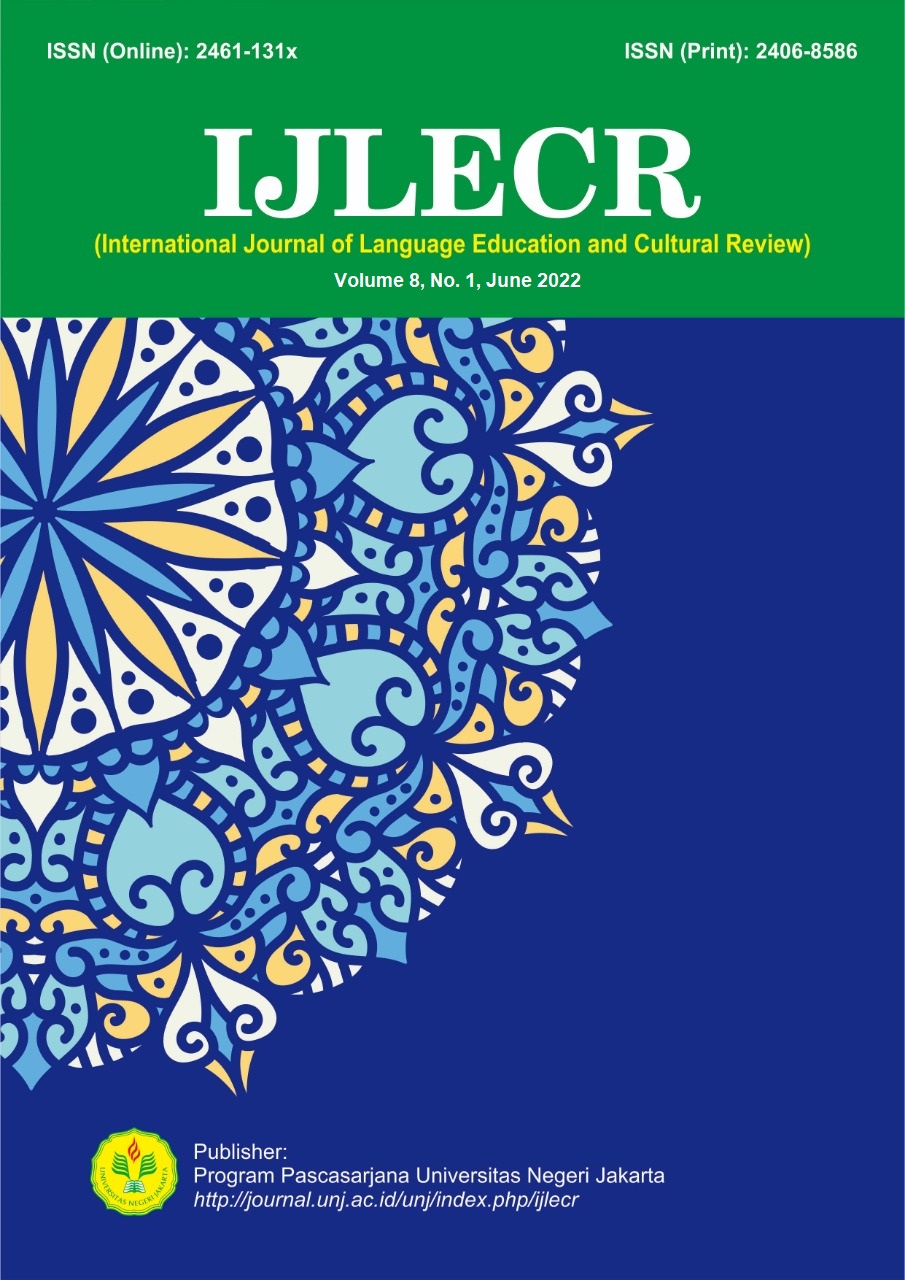THE LECTURERS’ IMMEDIACY ATTRIBUTES AND STUDENTS’ WILLINGNESS TO COMMUNICATE, ARE THEY CORRELATED?
DOI:
https://doi.org/10.21009/ijlecr.v8i1.28491Keywords:
Willingness to Communicate (WTC), Lecturers’ Immediacy Behaviors, Verbal Immediacy, Nonverbal Immediacy, EFLAbstract
The purposes of this research were two-fold: first, to see whether or not lecturers’ immediacy behaviors were linearly related to their students’ Willingness to Communicate (WTC); second, to determine which immediacy behavior (Verbal or Nonverbal) predominantly impacted on students’ WTC. To achieve the purposes, two types of questionnaires were utilized, 1) students’ WTC and 2) lecturers’ immediacy. Later, the participants were asked to choose 1–5 scales of question item. There were 122 EFL public university students from the Western part of Indonesia who partook in this study. They were involved voluntarily and chosen randomly. For data analysis, the bivariate calculation was applied to find the associations between the variables tested. Thus, SPSS 26 was utilized to meet the statistical analysis required. The result showed that the lecturers’ immediacy behavior was positively and strongly correlated to the students’ WTC with a correlation value of 0.716. However, if compared to nonverbal, lecturers’ verbal traits had given the strongest positive association. It was described by Pearson correlation value found, 0.689 (verbal) and 0.502 (nonverbal). With regard to the study’s findings, educators of all levels must be aware of their immediacy behaviors so that students’ WTC can be controlled in a positive way.
References
Alemi, M., Tajeddin, Z., & Mesbah, Z. (2013). Willingness to communicate in L2 English: Impact of learner variables. Journal of Applied Linguistics, 4(1), 42–61.
Andersen, J. F. (1979). Teacher Immediacy as a Predictor of Teaching Effectiveness. Annals of the International Communication Association, 3(1), 543–559. https://doi.org/10.1080/23808985.1979.11923782
Basoz, T. & Erten, I. H. (2019). A Qualitative Inquiry into the Factors Influencing EFL Learners’ in-class Willingness to Communicate in English. Novitas-ROYAL (Research on Youth and Language), 13(1), 1-18.
Cao, Y., & Philp, J. (2006). Interactional context and willingness to communicate: A comparison of behavior in whole class, group and dyadic interaction. System, 34(4), 480–493. https://doi.org/10.1016/j.system.2006.05.002
Christophel, D. M., & Gorham, J. (1995). A test-retest analysis of student motivation, teacher immediacy, and perceived sources of motivation and demotivation in college classes. Communication Education, 44(4), 292–306. https://doi.org/10.1080/03634529509379020
Dörnyei, Z. (2005). The Psychology of the Language Learner: Individual Differences in Second Language Acquisition. Lawrence Erlbaum Associates Publishers.
Fallah, N. (2014). Willingness to communicate in English, communication self-confidence, motivation, shyness and teacher immediacy among Iranian English-major undergraduates: A structural equation modeling approach. Learning and Individual Differences, 30, 140–147. https://doi.org/10.1016/j.lindif.2013.12.006
Gol, Maryam, Zand-Moghadam, Amir, Karrabi, M. (2014). The Construct of Willingness to Communicate and Its Relationship with EFL Learners’ Perceived Verbal and Nonverbal Teacher Immediacy. 3(1), 135–160.
Gorham, J. (1988). The relationship between verbal teacher immediacy behaviors and student learning. Communication Education, 37(1), 40–53. https://doi.org/10.1080/03634528809378702
Harmer, J. (2007). The Pratice of English Language Teaching (4th ed.). Cambridge, UK: Longman.
Hsu, L.L. (2005). The relationship among teachers’ verbal and nonverbal immediacy behaviors and students’ willingness to speak in English in central Taiwanese college classrooms. Doctoral dissertation, Oral Roberts University, Tulsa, Oklahoma.
Kang, S. J. (2005). Dynamic emergence of situational willingness to communicate in a second language. System, 33(2), 277–292. https://doi.org/10.1016/j.system.2004.10.004
Lee, J. H. (2020). Relationships among students’ perceptions of native and non-native EFL teachers’ immediacy behaviours and credibility and students’ willingness to communicate in class. Oxford Review of Education, 46(2), 153–168. https://doi.org/10.1080/03054985.2019.1642187
Lunenburg, F. C. (2010). Communication: The process, barriers, and improving effectiveness. Schooling, 1, 1–11.
MacIntyre, P. D. (1994). Variables Underlying Willingness to Communicate: A Causal Analysis. Communication Research Reports, 11(2), 135–142. https://doi.org/10.1080/08824099409359951
Macintyre, P. D., & Charos, C. (1996). Personality, attitudes, and affect as predictors of second language communication. Journal of Language and Social Psychology, 15(1), 3–26. https://doi.org/10.1177/0261927X960151001
MacIntyre, P., Clement, R., Dornyei, Z., & Noels, K. (1998). Conceptualizing willingness to communicate in a L2: A situational model of L2 confidence and affiliation. The Modern Language Journal, 82(4), 545– 562.
Manipuspika, S.Y. (2018). Correlation between Anxiety and Willingness to Communicate in the Indonesian EFL Context. Arab World English Journal, 9(2), 200–217. https://doi.org/10.24093/awej/vol9no2.14
Mehrabian, A. (1971). Verbal and nonverbal interaction of strangers in a waiting situation. Journal of Experimental Research in Personality, 5, 127–138.
Mehrabian, A. (1981). Silent Messages: Implicit Communication of Emotions and Attitudes. Childhood Education.
Myers, S. A., & Bryant, L. E. (2002). Perceived understanding, interaction involvement, and college student outcomes. Communication Research Reports, 19, 146-155.
Pattapong, K. (2015). Complex Interactions of Factors Underlying Thai EFL learners’ Willingness to Communicate in English. PASAA Journal of Language and Teaching, 49(1), 105-136.
Reinders, H. (2016, May 11). Understanding and Encouraging Willingness to Communicate in the Language Classroom #1. Cambridge University Press. https://www.cambridge.org/elt/blog/2016/05/11/understanding-encouraging-willingness-communicate-language-classroom-1/
Riasati, M. J. (2018). Willingness to speak English among foreign language learners: A causal model. Cogent Education, 5(1), 1–17. https://doi.org/10.1080/2331186X.2018.1455332
Richmond, V. P., Gorham, J. S., & Mccroskey, J. C. (1987). The relationship between selected immediacy behaviors and cognitive learning. Annals of the International Communication Association, 10(1), 574–590. https://doi.org/10.1080/23808985.1987.11678663
Şener, S. (2014). Turkish ELT students’ willingness to communicate in English. ELT Research Journal, 3(2), 91-109–109.
Sheybani, M. (2019). The relationship between EFL learners’ willingness to communicate (WTC) and their teacher immediacy attributes: A structural equation modelling. Cogent Psychology, 6(1). https://doi.org/10.1080/23311908.2019.1607051
Weda, S., Atmowardoyo, H., Rahman, F., Said, M. M., & Sakti, A. E. F. (2021). Factors Affecting Students' Willingness to Communicate in EFL Classroom at Higher Institution in Indonesia. International Journal of Instruction, 14(2), 719-734. https://doi.org/10.29333/iji.2021.14240a
Wen, W. P., & Clément, R. (2010). Language, Culture and Curriculum A Chinese Conceptualisation of Willingness to Communicate in. Language, Culture and Curriculum, 16 (August 2012), 37–41.
Yu, M. (2009). Willingness to communicate of foreign language learners in a Chinese setting. Unpublished doctoral dissertation. Florida State University, Florida, U.S.A.
Yu, M. (2011). Effect of communication variables, affective variables, and teacher immediacy on willingness to communicate of foreign language learners. Chinese Journal of Communication, 4(2), 218–236. https://doi.org/10.1080/17544750.2011.565678








